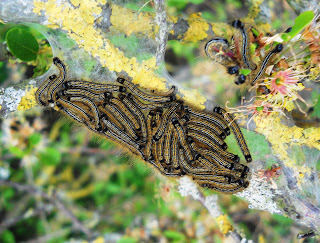This blog may help people explore some of the 'hidden' issues involved in certain media treatments of environmental and scientific issues. Using personal digital images, it's also intended to emphasise seasonal (and other) changes in natural history of the Swansea (South Wales) area. The material should help participants in field-based modules and people generally interested in the natural world. The views are wholly those of the author.
Friday, 22 April 2011
Seeing the Changes 377
Creeping cinquefoil (Potentilla reptans), Cultivated apple (Malus domestica) and Alexanders (Smyrnium olusatrum) were blooming in Loughor. In Bynea, noted Bluebells (Endymion non-scripta) and Field rose (Rosa arvensis). In Penclacwydd, Red campion (Silene dioica) and Greater stitchwort (Stellaria holostea). In that last location, many of the Hawthorn had tented colonies of small Lackey moth (Malacosoma neustria) larvae. In Loughor, visited by a Shield bug (Picromerus bidens). In Bynea, a Viviparous lizard (Zootoca vivipara) was flattened on the cycle path.
Subscribe to:
Post Comments (Atom)
-
I n the UK and US, a pparently popular and successful vegan/vegetarian restaurants are reportedly closing or adding meat to their menus ( ...
-
Early ripening fruit may seem convenient but some folk think it confirms environmental stress. There's also a possibility th...











%20mating%20NWCW.jpg)


No comments:
Post a Comment